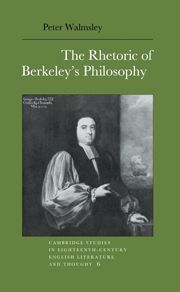Book contents
- Frontmatter
- Contents
- Acknowledgments
- Note to the reader
- Introduction
- PART I THE PRINCIPLES OF HUMAN KNOWLEDGE
- 1 Ideas and the ends of language
- 2 Locke, roles, and passion
- 3 The ends of morality and religion
- 4 Metaphor and the evidence of things not seen
- PART II THREE DIALOGUES BETWEEN HYLAS AND PHILONOUS
- PART III ALCIPHRON
- PART IV SIRIS
- Conclusion
- Select bibliography
- Index
4 - Metaphor and the evidence of things not seen
Published online by Cambridge University Press: 21 August 2009
- Frontmatter
- Contents
- Acknowledgments
- Note to the reader
- Introduction
- PART I THE PRINCIPLES OF HUMAN KNOWLEDGE
- 1 Ideas and the ends of language
- 2 Locke, roles, and passion
- 3 The ends of morality and religion
- 4 Metaphor and the evidence of things not seen
- PART II THREE DIALOGUES BETWEEN HYLAS AND PHILONOUS
- PART III ALCIPHRON
- PART IV SIRIS
- Conclusion
- Select bibliography
- Index
Summary
When Berkeley's predecessors formulated their strictures on language, their mistrust focused chiefly on metaphor. Hobbes accounted it an ‘abuse of speech’ to ‘use words metaphorically; that is, in other sense than that they are ordained for; and thereby deceive others’. Locke's objections were more fundamental and just as damning. He makes an absolute distinction between judgment, the process by which we distinguish ideas so that we may better reason about them, and wit, which is devoted to ‘the assemblage of Ideas’. Metaphor for Locke is the prime manifestation of wit, and though it may please, it cannot withstand scrutiny ‘by the severe Rules of Truth’. These observations did not hinder either philosopher from a free use of metaphor in his own writings, but the theoretical bases of their objections are clear. In metaphor the mind exercises its ability to find likeness between apparently unlike sensible ideas. Unless our sensory experiences–our pristine, determinate ideas–are granted a higher order of reality than the products of reflection or fancy, the empiricist's claim on truth crumbles. For this very reason Berkeley should have joined the refrain against metaphor. He maintains a qualitative distinction between the ‘real’, God-given ideas of sense and the faint, chimerical creations of the imagination.
Berkeley does not renounce metaphor in the course of his Introduction's examination of language, but he does make this stern pronouncement late in Part I:
But nothing seems more to have contributed towards engaging men in controversies and mistakes, with regard to the nature and operations of the mind, than the being used to speak of those things, in terms borrowed from sensible ideas. […]
- Type
- Chapter
- Information
- The Rhetoric of Berkeley's Philosophy , pp. 48 - 58Publisher: Cambridge University PressPrint publication year: 1990

